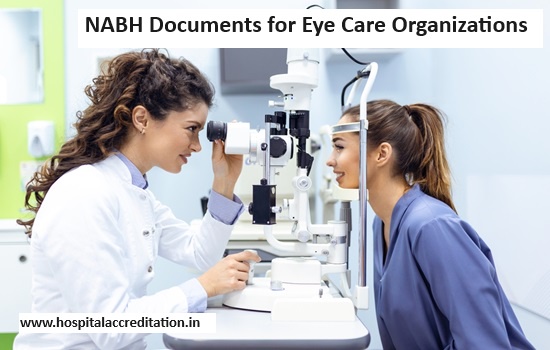The National Accreditation Board for Hospitals & Healthcare Providers (NABH) in India is the organization that created the NABH Standards for Eye Care Organizations. The standards are intended to evaluate and recognize eye care facilities that uphold strict criteria for patient safety and excellence. The guidelines are intended to assist eye care organizations in raising the standard of care they offer to their patients. They are founded on the most recent evidence-based practices.
Which NABH Standards Apply to Eye Care Organizations?
Strict guidelines have been set by the National Accreditation Board for Hospitals & Healthcare Providers (NABH) for eye care facilities to provide the best possible treatment and patient security. The delivery of eye care is covered by these guidelines in several ways, including patient access, evaluation, medication administration, and infection control. The collection of NABH documentation packages from the Eye Care Organization - NABH hospital accreditation will help ensure a successful accreditation process.
The main NABH guidelines for eye care facilities are outlined below:
Continuity of Care, Access, and Assessment (AAC):
- Assure prompt and fair access to eye care services for every patient.
- Perform comprehensive evaluations of patients to ascertain their requirements and create suitable treatment programs.
- By arranging follow-up consultations and collaborating with other medical professionals, you can preserve continuity of care.
Care of Patients (COP):
- Give a safety, effective, patient care which is based on evidence-based practices and guidelines.
- For the management of different eye conditions, use the proper diagnostic techniques and therapeutic approaches.
- Inform patients about self-care techniques, available treatments, and eye disorders.
Management of Medication (MOM):
- To guarantee that prescriptions are written, dispensed, administered, and stored safely and effectively, a strong medication management system should be established.
- Through routine monitoring, reconciliation, and patient education, avoid prescription errors and adverse drug responses.
- Adopt guidelines and protocols for managing dangerous drugs and restricted substances.
Patients’ Rights and Education (PRE):
- Respect and justify the patients to the informed, approval and privacy.
- Give patients clear and knowledgeable information about their eye conditions.
- Motivate the patients to participating in the decision-making and empower them to oversee their eye health.
HIC, or Hospital Infection Control:
- Establish a thorough infection control program to stop and manage the spread of infections inside the eye clinic.
- Make sure that all staff members are practising good hand hygiene, and make sure that all tools and equipment are properly sterilized.
- Keep all sections of the facility—including the staff, common, and patient care spaces—clean and hygienic.
Constant Quality Enhancement (CQI):
- Create an organizational culture that is centred on constant assessment, monitoring, and evaluation of eye care services to foster a culture of continuous quality improvement.
- Determine what needs to be improved by using patient feedback channels, root cause analysis, and performance monitoring.
- Take action on quality improvement projects to close gaps found and raise the standard and safety of care.
Responsibility of Management:
- Assure the organization’s leadership is committed to upholding the highest standards of quality and patient safety in eye care.
- Give the resources and support to the staff members to effectively implement the NABH standards.
- Create a governance structure that guarantees responsibility, openness, and efficient risk management.
Facility Management and Safety (FMS):
- Keep the physical environment secure and maintained by building codes, accessibility requirements, and fire safety rules.
- Use efficient waste management techniques to reduce the negative effects on the environment and stop the spread of illness.
- To efficiently handle possible catastrophes and disasters, establish strategies and procedures for emergency preparedness.
Human Resource Management (HRM):
- Provide and execute an all-encompassing strategy for managing human resources that draws in, hires, and keeps skilled and certified eye care specialists.
- Employees should have access to continual education and training to improve their skills and understanding of eye care procedures.
- Put performance management mechanisms in place to assess employee performance and offer chances for professional growth.
System for Managing Information (IMS):
- To efficiently gather, store, and handle patient data, medical records, and quality improvement data, a strong information management system should be established.
- In compliance with ethical guidelines and data privacy laws, make sure patient information is secure and secret.
- Make use of information technology to assist with performance evaluation, clinical decision-making, and quality-enhancing projects.
Eye care organizations can exhibit their dedication to delivering patient-centred, high-quality care while guaranteeing the safety and well-being of their patients by complying with these essential NABH standards.


No comments yet